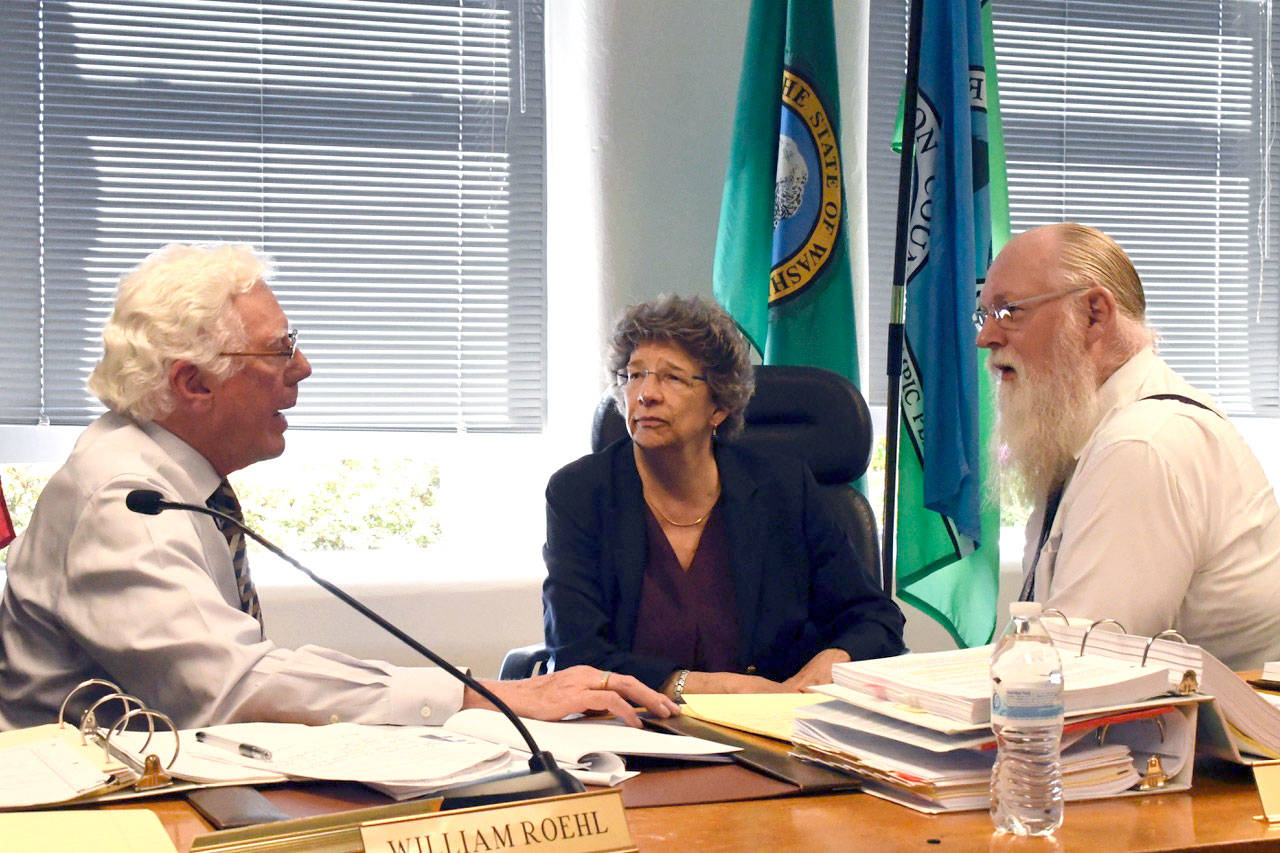PORT TOWNSEND — The Growth Management Hearings Board heard final arguments in an appeal by the Tarboo Ridge Coalition that alleges that Jefferson County violated state law when it adopted gun range ordinances Title 8 and Title 18.
Interested Jefferson County residents filled the commissioners’ meeting room Tuesday during the hearing while a spillover crowd stood in the hall to witness the nearly three-hour meeting.
Seattle attorney Alex Sidles of Bricklin & Newman said that the Tarboo Ridge Coalition (TRC), which has opposed Joe D’Amico’s proposed 40-acre shooting range near Tarboo Lake, is appealing both Title 8 and Title 18.
He said the laws open up productive forest land for a shooting range and claimed that the county erred when it did not allow public comment on the issue.
“This is not a development regulation,” Philip Hunsucker, chief civil prosecuting attorney, who represented the county along with Austin Watkins, civil deputy prosecutor, told the board.
“TRC’s efforts were to stop one shooting facility project before a conditional use application was even filed,” Hunsucker said. “Our focus as a county was not just on one shooting facility.
“Instead we were focused on providing uniform regulations for commercial shooting facilities across the county.”
The hearing has no impact on the Jefferson County Sportsmen’s Association gun range because it is a facility that is has been in existence for more than 50 years on county-owned property and has been grandfathered in.
Nina Carter of Olympia, western region president of the Growth Management Hearings Board (GMHB) said that the hearing was intended to clarify four issues raised by TRC. She served on the board along with William Roehl, an attorney from Bellingham, and Bill Hinkle, a former state legislator from Cle Elum.
The four issues are:
• If Title 8 constitutes some kind of development regulation that the GMHB would have jurisdiction over.
• If, in adopting Title 8 without planning commission review, the county violated the public participation program as required in the GMA.
• If Title 8 requires a State Environmental Protection Act (SEPA) review.
• Was the county’s action in passing the ordinances consistent with the county’s land use plan.
A final decision will be announced on July 17 and will be available on the Growth Management Hearings Board website at www.gmhb.wa.gov under the Case and Decision Search tab.
Sidles said that in 2017, prior to the adoption of the ordinances, gun ranges were required to be limited in size and intensity of use.
“The primary source of the limitations included a limit of one gun range per parcel and all gun ranges had to be ‘small scale recreation and tourist use,’” he said. “We believe the old gun range regulation scheme was compatible with forestry.
“These new gun range regulation schemes that the county has adopted are incompatible with forestry and foresting with long-term significance which is in conflict with the Jefferson County Comp Plan which protects forest lands of significance, and it also violates the GMA (Growth Management Act) itself which requires protections of forest lands,” Sidles said.
Sidles said those isolated uses that are recreational and leisure in nature are reliant upon a rural setting or location that do not include any new residential development which is allowed in the land use district.
He said Jefferson County has “a history of failing to protect forest lands” by allowing outdoor shooting facilities to be sited in Commercial Forest, Rural Forest and Inholding Forest lands.
Said Hunsucker: “We chose to put safety first and pass an operating permit ordinance that was not a land use ordinance that applied to all commercial shooting facilities. That’s Tile 8.
”Then we turned to land use and that’s the Title 18 ordinance to close loopholes in the unified development code.
“We continued to rely on our unambiguous conditional use permit approval criteria. We believe that other parts of the county’s code work in harmony with Title 18. The Title 8 and Title 18 work in harmony.”
Peter Newland, TRC board member, said he was happy with the presentation.
“The big concern is that there are no longer any bright lines that define what gun ranges are,” he said. “That is a threat to our economy and that is a threat to our economy and our personal safety.”
After the meeting, Sidles said the “two pivotal issues are if there a land use regulation here at all and if not, then this is all in vain and it doesn’t mean anything,” Sidles said.
“When they ask,’ Does the berm make it a land use regulation, does noise make it a land use regulation,’ that’s what they are getting it. That’s a critical threshold. If this is a development regulation, does this protect forestry as it is supposed to. The county believes that the only protection forests need are the hearing examiner. We believe that forests need standards, not just an examiner’s unguided discretion, but standards in the code to say here’s how big a range can be before it starts to conflict with forestry.
“This is not a lawsuit about Joe D’Amico’s range. The rules they’ve adopted relate to all gun ranges in the county. Once you tear the trees out and dig berms and put up structures, the trees won’t be growing there for a long time.”
Hunsucker was cautiously optimistic.
“I think it went fine. You never know from a hearing what people are going to do. You could perhaps sense a change over the course of the hearing and tenor of what’s going on. They are going to deliberate and make a decision and we’ll deal with it. . . They asked hard questions of both sides.”
Said Carter: “The Growth Management Act says we must presume the county’s actions were valid,” Carter said. “That’s the assumption we walk in with. It’s the petitioner’s burden to show the county’s action was not.
________
Jefferson County Reporter Jeannie McMacken can be reached at 360-385-2335 or at jmcmacken@peninsuladailynews.com.

